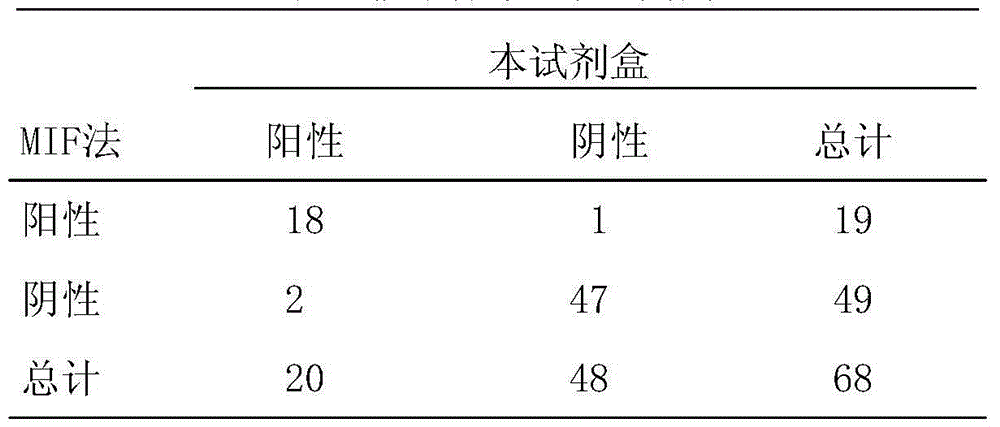Method and kit for fast detection of human chlamydia pneumoniae antigen based on magnetic resolution and quantum dot labelling
A Chlamydia pneumoniae, magnetic separation technology, applied in the field of medical detection, can solve the problems of long cell culture time, unsatisfactory sensitivity, specificity and repeatability, and inability to directly identify Chlamydia pneumoniae
- Summary
- Abstract
- Description
- Claims
- Application Information
AI Technical Summary
Problems solved by technology
Method used
Image
Examples
Embodiment 1
[0082] Example 1 Preparation of rabbit and mouse anti-human Chlamydia pneumonia 98KD membrane protein polyclonal antibody IgG
[0083] (1) Preparation and purification of recombinant M98-His fusion protein
[0084] 1. Cloning of related genes
[0085] The 98KD membrane protein of human Chlamydia pneumoniae (the accession number in the NCBI protein database is CAA04672) was analyzed by bioinformatics, and the peptide fragment with the most abundant epitope in the extracellular conserved domain was obtained, and the corresponding DNA coding sequence was found. After introducing the restriction site NdeI at the 5'end of the sequence, the termination signal TAA and the restriction site XhoI at the 3'end, the complete gene sequence is chemically synthesized (the complete sequence synthesis is completed by GenScript Biotechnology Co., Ltd., and artificially synthesized upon delivery Attached to the vector pUC57), denoted as m98. The complete gene sequence is shown in the sequence table. ...
Embodiment 2
[0100] Example 2 Preparation of anti-human Chlamydia pneumoniae immune nano magnetic beads
[0101] 1. Optimization of reaction conditions for anti-human Chlamydia pneumoniae polyclonal antibody coupled to magnetic beads:
[0102] Using magnetic beads coupled with anti-human Chlamydia pneumoniae 98KD membrane protein polyclonal antibody as solid phase carrier, quantum dot-labeled anti-human Chlamydia pneumoniae 98KD membrane protein polyclonal antibody as detection antibody, detection of human Chlamydia pneumoniae by the principle of double antibody sandwich method Antigen, observe the coupling between magnetic beads and polyclonal antibody. A series of optimization selections were made for the particle size of the magnetic beads, the concentration of EDC / NHS activator, the concentration of coupling antibody, coupling time, and the type of blocking agent.
[0103] 1.1 Selection of magnetic bead size
[0104] Choose the carboxyl magnetic beads with particle size of 50nm, 180nm, 350nm,...
Embodiment 3
[0115] Example 3 Preparation of quantum dot-labeled anti-human Chlamydia pneumoniae nanoprobe
[0116] 1. Optimization of IgG reaction conditions for mouse anti-human Chlamydia pneumonia 98KD membrane protein polyclonal antibody labeled with nano-carboxyl quantum dots:
[0117] 1.1. Determination of the optimal labeling pH for carboxyl quantum dot labeled antibody probe
[0118] The pH of the phosphate buffer in the labeling reaction was set to 5, 6, 7, 8, 9 respectively. The fluorescence intensity of the labeled product was measured by a full-spectrometer, and the effect of different pH values on the coupling reaction was observed. Quantum dot-labeled polyclonal antibodies were determined The optimal pH of the reaction is 7.0-8.0. This experiment chooses pH7.4.
[0119] 1.2 Determination of the optimal labeling amount of carboxyl quantum dot-labeled antibody probe
[0120] Set the ratio of the molar concentration of quantum dots to the concentration of polyclonal antibody to 1:1, 1...
PUM
| Property | Measurement | Unit |
|---|---|---|
| Particle size | aaaaa | aaaaa |
| Magnetic strength | aaaaa | aaaaa |
| Particle size | aaaaa | aaaaa |
Abstract
Description
Claims
Application Information
 Login to View More
Login to View More - R&D
- Intellectual Property
- Life Sciences
- Materials
- Tech Scout
- Unparalleled Data Quality
- Higher Quality Content
- 60% Fewer Hallucinations
Browse by: Latest US Patents, China's latest patents, Technical Efficacy Thesaurus, Application Domain, Technology Topic, Popular Technical Reports.
© 2025 PatSnap. All rights reserved.Legal|Privacy policy|Modern Slavery Act Transparency Statement|Sitemap|About US| Contact US: help@patsnap.com


